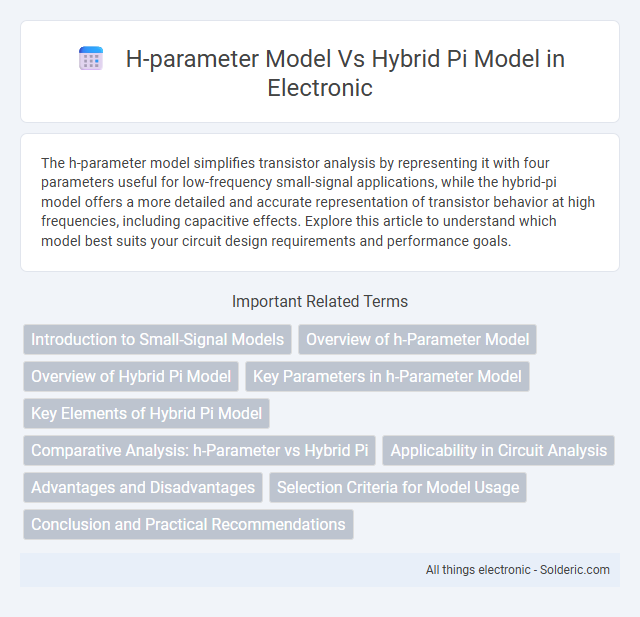The h-parameter model simplifies transistor analysis by representing it with four parameters useful for low-frequency small-signal applications, while the hybrid-pi model offers a more detailed and accurate representation of transistor behavior at high frequencies, including capacitive effects. Explore this article to understand which model best suits your circuit design requirements and performance goals.
Comparison Table
| Feature | H-Parameter Model | Hybrid-Pi Model |
|---|---|---|
| Application | Low-frequency transistor analysis | Small-signal high-frequency transistor analysis |
| Parameter Types | h11, h12, h21, h22 | r_pi, gm, r_o, C_pi, C_mu |
| Model Type | Two-port network parameter model | Small-signal equivalent circuit |
| Frequency Range | Low frequency | High frequency |
| Parameters Representation | Impedance and voltage gain parameters | Transconductance and parasitic capacitances |
| Usefulness | Simplifies circuit analysis for low-freq BJTs | Accurate modeling for high-frequency transistor behavior |
| Control Variables | Input current and output voltage | Input voltage controlling output current |
Introduction to Small-Signal Models
Small-signal models like the h-parameter and hybrid-pi models provide linearized approximations of transistor behavior for analyzing AC response. The h-parameter model uses four parameters (h_ie, h_re, h_fe, h_oe) to describe input impedance, reverse voltage gain, forward current gain, and output admittance, suitable for low-frequency analysis. The hybrid-pi model incorporates transistor internal resistances and transconductance, offering higher accuracy for high-frequency applications and more precise representation of your circuit's dynamic performance.
Overview of h-Parameter Model
The h-parameter model represents a two-port network using four hybrid parameters that relate input and output voltages and currents linearly, simplifying transistor analysis in low-frequency applications. It expresses the input voltage and output current as functions of input current and output voltage, making it practical for characterizing bipolar junction transistors (BJTs) with measurable parameters like h_ie, h_re, h_fe, and h_oe. Your circuit design benefits from this model's straightforward representation, especially when dealing with amplifier stability and small-signal variations.
Overview of Hybrid Pi Model
The Hybrid Pi Model accurately represents the transistor's small-signal behavior, incorporating parameters like input resistance (rp), transconductance (gm), and output resistance (rO) for precise analysis of amplifier circuits. It is widely favored in analog circuit design due to its effectiveness in modeling the transistor's voltage gain, input impedance, and output impedance under varying operating conditions. This model provides a more detailed and realistic depiction of transistor characteristics compared to the simpler h-parameter model, making it essential for high-frequency and accuracy-dependent applications.
Key Parameters in h-Parameter Model
The h-parameter model's key parameters include h11 (input impedance), h12 (reverse voltage gain), h21 (forward current gain), and h22 (output admittance), which collectively simplify transistor analysis in low-frequency applications. These parameters allow you to easily represent the transistor's behavior using two-port network equations, making circuit calculations straightforward. Unlike the hybrid pi model, which focuses on high-frequency and small-signal behavior with parameters like r_pi and gm, the h-parameter model provides a more intuitive approach for DC and mid-frequency characteristics.
Key Elements of Hybrid Pi Model
The hybrid pi model features key elements such as the input resistance (rp), representing base-emitter resistance, and the controlled current source (gm*vp) symbolizing the transconductance effect of the transistor. It also incorporates the output resistance (ro) to account for the Early effect, providing a more accurate representation of transistor behavior at high frequencies compared to the simpler h-parameter model. Understanding these components helps you analyze and design transistor amplifiers with improved precision.
Comparative Analysis: h-Parameter vs Hybrid Pi
The h-parameter model offers simplicity and ease of use in low-frequency transistor analysis by using four fixed parameters representing input impedance, forward voltage gain, reverse current gain, and output admittance. The hybrid pi model provides a more accurate representation for high-frequency applications, incorporating parameters such as transconductance, input resistance, output conductance, and base-emitter capacitance to capture frequency-dependent behavior. While the h-parameter model is optimal for DC and low-frequency small-signal analysis, the hybrid pi model excels in modeling frequency response and stability in bipolar junction transistor circuits.
Applicability in Circuit Analysis
The h-parameter model is primarily used for analyzing transistor amplifiers in low-frequency applications due to its simplicity and direct relation to transistor parameters. The hybrid pi model offers greater accuracy in high-frequency circuit analysis by incorporating transistor capacitances and more detailed internal transistor behavior. Engineers select the h-parameter model for straightforward DC and low-frequency analysis, while the hybrid pi model is preferred for high-frequency small-signal AC circuit analysis.
Advantages and Disadvantages
The H-parameter model offers simplicity and direct measurement advantages for transistor analysis, making it easy to use in low-frequency applications, but it lacks accuracy at higher frequencies and complex circuit conditions. The hybrid pi model provides a more accurate representation for high-frequency and small-signal analysis, capturing transistor behavior more precisely with its detailed parameter set, yet it requires more complex calculations and parameter extraction. Your choice depends on the required precision and application frequency, balancing ease of use against model accuracy.
Selection Criteria for Model Usage
The selection between the H-parameter model and the hybrid p model depends primarily on the application context, such as frequency range and circuit complexity. The H-parameter model is preferred for low-frequency analysis due to its simplicity and direct measurement parameters, while the hybrid p model excels in high-frequency and small-signal transistor modeling by capturing parasitic capacitances more accurately. Your choice should align with the desired accuracy and the specific electrical characteristics of the transistor under investigation.
Conclusion and Practical Recommendations
The h-parameter model offers simplicity and ease of use for low-frequency transistor analysis, making it suitable for straightforward circuit designs. The hybrid pi model provides greater accuracy at high frequencies due to its detailed representation of transistor capacitances, essential for RF and high-speed applications. You should choose the h-parameter model for basic small-signal analysis and the hybrid pi model when precise frequency response prediction is critical.
h-parameter model vs hybrid pi model Infographic

 solderic.com
solderic.com